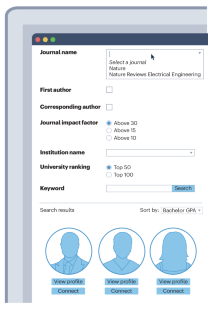The way in which researchers, scientists and engineers apply for jobs is very inefficient. Creating free online databases of candidates with filtering, ranking and video features could help to maximize reach and identify the most suitable person for each job offer much faster.
This is a preview of subscription content, access via your institution
Access options
Subscribe to this journal
Receive 12 digital issues and online access to articles
$119.00 per year
only $9.92 per issue
Buy this article
- Purchase on Springer Link
- Instant access to full article PDF
Prices may be subject to local taxes which are calculated during checkout

References
Ngo. M. America’s semiconductor boom faces a challenge: not enough workers. New York Times https://go.nature.com/4db4CgB (19 May 2023).
Anders, G. Can you wait 49 days? Why getting hired takes so long in engineering. LinkedIn https://go.nature.com/4bbuPto (5 August 2021).
Navarra, K. The real costs of recruitment. Society for Human Resource Management https://go.nature.com/44hvAyR (11 April 2022).
Semiconductor Industry Association. America faces significant shortage of tech workers in semiconductor industry and throughout the U.S. economy. https://go.nature.com/44e2mkG (July 2023).
Mohan, P. This university is addressing the shortage of U.S. semiconductor engineers. FastCompany https://go.nature.com/3UztaJ1 (2 March 2023).
Schooley, S. How to handle a bad hire. Business.com https://go.nature.com/3wfxbss (23 March 2023).
European Data Protection Supervisor. Security Measures for Personal Data Processing, Article 22 of Regulation 45/2001; https://go.nature.com/3Uibdx0 (21 March 2016).
Ioannidis, J., Klavans, R. & Boyack, K. Thousands of scientists publish a paper every five days. Nature 561, 167–169 (2018).
University of Zurich. UZH to No Longer Provide Data for THE Ranking https://go.nature.com/4baG2dX (13 March 2024).
Author information
Authors and Affiliations
Corresponding author
Ethics declarations
Competing interests
M.L, N.G. and V.Z. are members of the Workforce Advisory Board of the Semiconductor Research Corporation (USA), which aims to support talent recruitment for semiconductor ecosystem. M.L. has economic interest in the platform Web of Talents.
Additional information
Related links
Google Scholar: https://scholar.google.com/
Graduate Research Fellowship Program: https://www.nsfgrfp.org/
Linkedin: https://linkedin.com
National Science Foundation Engineering Postdoctoral Fellowships: https://efellows.asee.org/home
Semiconductor Research Corporation: https://www.src.org/about/
Stanford Budgeting Postdoc Fellowship guidelines: https://postdocs.stanford.edu/budgeting-postdoc-fellowship
Stanford Estimated Expense for Graduate Students: https://www.nsfgrfp.org/
UpWork: https://upwork.com
Web of Talents: https://weboftalents.com
Rights and permissions
About this article
Cite this article
Lanza, M., Godfrey, N. & Zhirnov, V. Solving the problem of hiring in STEM. Nat Rev Electr Eng (2024). https://doi.org/10.1038/s44287-024-00056-3
Published:
DOI: https://doi.org/10.1038/s44287-024-00056-3
